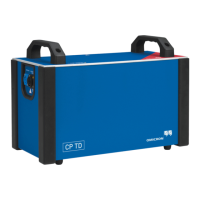Preface
11
Before performing tests using high voltage, observe the following instructions:
• Do not use the test equipment without a good connection to substation
ground.
• Do not insert objects (for example screwdrivers, etc.) into any input/output
socket.
• Do not operate the CP TD1 under ambient conditions that exceed the
temperature and humidity limits listed in 11.2 "Environmental Conditions" on
page 123.
• Make sure to position the test equipment on dry, solid ground.
• Do not operate the CP TD1 in the presence of explosives, gas or vapors.
• Opening the CP TD1 invalidates all warranty claims.
• Do not use an extension cable on a cable reel to prevent an overheating of
the cord; run out the extension cord.
• If the CP TD1 does not seem to function properly, do not use it anymore.
Please call the OMICRON electronics technical support.
Handling Cables
• Always turn off the CP TD1 completely before you connect or disconnect any
cable (disconnect the CPC 100 from mains or press its Emergency Stop
button).
• The high-voltage cable must always be well attached and tightly connected
to both the CP TD1 and the test object. A loose or even falling off connector
at the test object carrying high-voltage is life-hazardous. Make sure the
connectors are clean and dry before connecting.
At the CP TD1, press the high-voltage cable’s plug to the connector tightly
and turn the screw cap until you feel a mechanical stop. If you notice a rough-
running of the screw-cap, clean the screw thread and use a lubricant
(vaseline recommended).
At the test object, insert the high-voltage cables’ plugs carefully until you feel
a "click" position. Now they are locked. Confirm this by trying to pull them out.
This should not be possible now.
Note: Tighten the plugs manually. Do not use any tools for that because that
can damage the plugs or connectors.
Insert the yellow banana plug (the high-voltage cable’s grounding) into the
respective plug socket.

